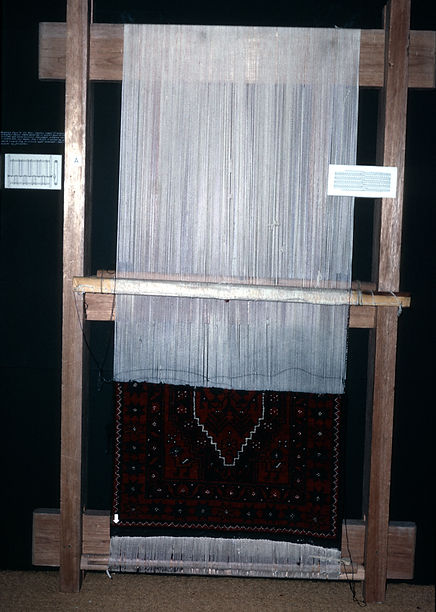Ancient Looms, 1967
In 1967, Margrethe Hald curated and organized a large exhibition at the National Museum in Copenhagen on the occasion of her retirement. The exhibition, which afterwards travelled to Forhistorisk Museum (today Moesgaard) in Aarhus was entitled “Oldtidsvæve” (Ancient Looms). A number of looms that Hald collected on her travels were shown at the exhibition, among them several looms set up for tubular weaving alongside the so-called 'Huldremose peplos'. An exhibition catalogue in Danish was published by Forhistorisk Museum (today Moesgaard) in Aarhus, which has been digitised in 2019 and can be accessed here: KMBT_C454-20181221162319 (ku.dk)

Two-beam loom set up for pile weave, acquired by Hald in Fiki/Fakieh, Lebanon, 1961. The loom belongs to the National Museum, GenReg no. F.854. Slide marked “349 Syrien. Udst. 1967”.

Two-beam loom set up with a tubular warp using the spiral method. The loom was acquired by Hald in Ecuador in 1966. It belongs to the National Museum of Denmark, GenReg no. H7043. Slide marked “524 Ecuador. Udst. 1967”. CTR.
The Huldremose peplos

This renowned archaeological textile was found in the Huldremose bog by a peat cutter in 1896. It is also known as ��“Huldremose II” since another important find was made in 1879. The textile forms a tubular garment and measures 173 h x 256 w cm. The find has been C14-dated to the Pre-Roman Iron Age, approximately 350-30 BC. Photo by Lennart Larsen. The National Museum of Denmark.

The Huldremose peplos was studied by Hald in the 1940s. She discovered that the large, well-preserved fabric had an almost invisible unifying cord that held the fabric together as a woven tube. This discovery led her to work out that the Huldremose II and several other textile finds must have been woven on a two-beam loom utilizing the loop method. Photo by Lennart Larsen. The National Museum of Denmark

The peplos from the back. Photo by Lennart Larsen. The National Museum of Denmark.

This renowned archaeological textile was found in the Huldremose bog by a peat cutter in 1896. It is also known as “Huldremose II” since another important find was made in 1879. The textile forms a tubular garment and measures 173 h x 256 w cm. The find has been C14-dated to the Pre-Roman Iron Age, approximately 350-30 BC. Photo by Lennart Larsen. The National Museum of Denmark.
Review of the original exhibition
Exhibition Review by weaver and chairman of the Danish Weavers’ Guild M. K. Paulli Andersen. Published in the journal of Haandarbejdets Fremme, 1967. Text in Danish and English.

Describe your image

Describe your image

Describe your image

Describe your image
Copyright belongs to CTR and the heirs of Margrethe Hald, unless stated otherwise.